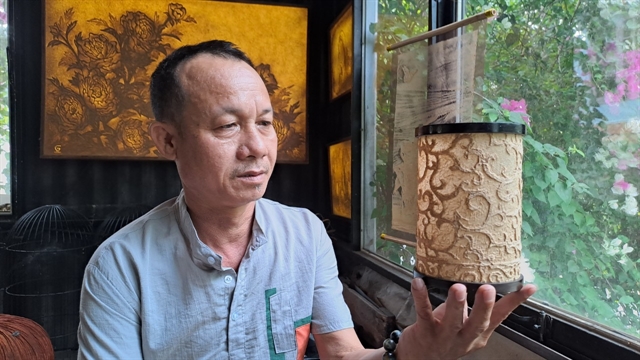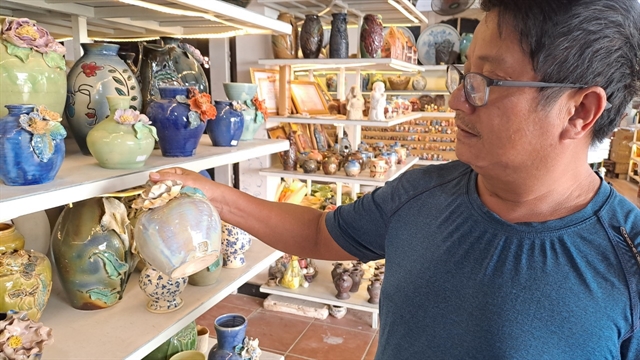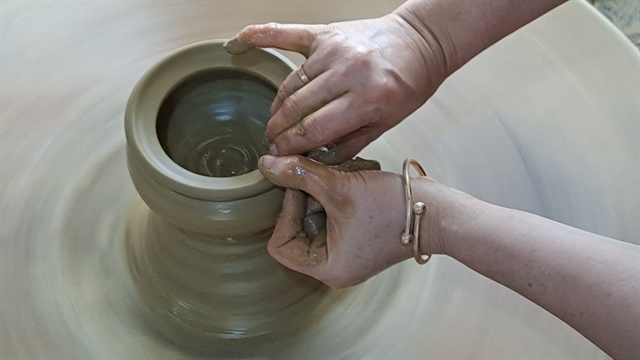 Sunday/Weekend
Sunday/Weekend

By Công Thành
 |
| Hoàng Anh Tuấn, a craftsman in Cẩm Thanh Commune, makes a bamboo fish for decoration. The suburbs of Hội An ancient town have been seen as an attraction to tourists in terms of wetland conservation and craft preservation. VNS Photo Công Thành |
Hội An Ancient Town has been launching a series of ‘green’ tourism initiatives boosting zero waste, non-plastic use, low carbon, energy saving, chemical-free agrotourism and recycling among more than 100 resorts, hotels and restaurants.
And ‘green’ tourism, innovative crafts, nature and culture protection will play a key focus of the UNESCO World Heritage Site’s hospitality industry in the future, in line with global sustainable travel trends.
A key part of this development is the work of a group of local artisans who are working to develop ecotourism and sustainable crafts.
Hội An, in the south-central province of Quảng Nam, is now boasting about having national heritage certificates for Thanh Hà Pottery village; the carpentry of Kim Bồng Village, vegetable planting in Trà Quế Village, and the mid-autumn Full Moon Festival, among others, and the list is likely to grow.
Hoàng Anh Tuấn, a craftsman in Cẩm Thanh Commune, 5km from Hội An, sitting under the thatched roof of his workshop, delicately joined some 400 bamboo pieces in the shape of a huge Koi fish that will be used for interior decoration – an innovative product made at this ecotourist commune.
The bamboo fish is one of a series of products that Tuấn and a group of craftsmen at the Taboo Bamboo workshop – a leading craft centre – have designed and produced, diversifying hand-made products available for tourists.
Innovate ancient craft
Tuấn, 40, grew up in Cẩm Thanh, and has revived his family trade for the community to promote crafts as a tourist experience.
 |
| Võ Tấn Tân, the owner and innovative mastermind, shows a bamboo art creation at the Taboo Bamboo workshop in Cẩm Thanh Commune on the outskirts of Hội An City. VNS Photo Công Thành |
“It takes me a month to complete a bamboo fish. Hundreds of bamboo pieces of different shapes and sizes were used to make the eye-catching animal,” Tuấn said.
“The shop is really a rendezvous for craft innovation ideas and practice. Numerous beautiful souvenirs, kids’ bikes, toys, portable lanterns, and interior decorations were born from the hard work of these craftsmen.”
Võ Tấn Tân, the owner and creator of the workshop, said: “Artisans in the commune have to innovate their ancient craft, catching the global trend in sustainable tourism. Any new ideas and designs derived from daily life are welcomed and put into test production at the shop immediately. We have tried to introduce more new designs, and this needs us to be creative and use our brains.”
The shop is aiming to become part of an eco-tour, an innovative craft destination in the commune, and a low-carbon and non-plastic site.
 |
| A local artisan introduces a nipa palm paper lantern. The craft has been listed in the UNESCO Creative Cities Network for boosting sustainable traditional trade preservation. VNS Photo Công Thành |
The residents in Cẩm Thanh Commune have lived well from their craft for generations, and the trade now contributes the added value by being part of a range of ecotourism services.
The communal bamboo- and nipa palm-based craft is one of 50 crafts that helped Hội An to list in the UNESCO Creative Cities Network.
"Nipa palm paper is a 'green' material, so the arts and crafts creations from the paper lure customers.”
Huỳnh Năm, craftsman
Nguyễn Văn Lanh, vice chairman of Hội An City’s People’s Committee (municipal administration), said such the recognition also helped highlight the community-based tourism and crafts in the commune of Tân Hiệp in Chàm Islands, off the coast of Hội An, and Cẩm Thanh in the ancient town's suburbs.
Crafted artwork
Trương Tấn Thọ, an owner of a nipa palm arts and crafts shop in the commune, had an initiative to produce paper pulp from nipa palm branches to make nipa palm paper for decoration. The Giấy Việt (Vietnam Paper) garden offers the new natural material, inspired by traditional dó (poonah) paper.
 |
| Nguyễn Viết Sơn, a potter in Thanh Hà pottery village in Hội An City, shows innovative pieces of pottery at his Sơn Thủy shop. VNS Photo Công Thành |
“I use the technique of making dó paper, but use nipa palms to make pulp instead of wood or bamboo. Napa palm is the native plant of Cẩm Thanh Commune,” Thọ said.
“We can use dead and pruned branches of a nipa palm. From nipa palm pulp, we can make various kinds of paper and cardboard. We use the new material as canvas for painting, or to make hand fans, lanterns, door curtains, ceiling panels, and gift packaging, instead of using plastic or cloth.”
Huỳnh Năm, 50, a craftsman, said: “Most of the customer orders are for home interior decorations and landscape paintings. Nipa palm paper is a 'green' material, so the arts and crafts creations from the paper lure customers.”
Born in Thanh Hà pottery village, a favourite destination in the Old Quarter of Hội An, Nguyễn Viết Sơn, 49, has revived his six-generation family’s craft at Sơn Thuỷ shop. The business has recently renovated its products and designs.
“Previously, the pottery production used firewood kilns, but these were changed to electric or gas to create fewer emissions. We now use colour enamel for high-quality pottery products,” Sơn said.
“The village used to make kitchenware, pots or stoves for markets, but visitors to the village want to take a piece of the destination home. It’s why we now focus on making souvenirs and gifts to take away. Products at the shop are hand-made, not mass produced.”
Unique products
Nguyễn Viết Lâm, 26, Sơn’s son, designs most of the products, and said the potters had to make unique products to survive.
 |
| A clay jar is shaped on a potter's wheel in Thanh Hà Village of Hội An City. All products at the village are hand-made. VNS Photo Công Thành |
He said the village’s trade would only be preserved if its terracotta products were marketable.
The young potter emphasised that combining traditional techniques with new technology applications as well as digitalisation would help preserve and develop the trade.
Artist Lê Ngọc Thuận has promoted his wares at the much-favoured An Bàng beach, carving scrap wood at carpentry shops in the traditional Kim Bồng carpentry village into sculptures.
Thuận gathered the best carpenters from the village to make his own Driftwood Village, the first wood recycling space in Hội An.
He said the art creation offered a ‘green’ choice for tourists, and the community in Hội An has been promoting ‘green’ tourism focusing on recycling, environmentally friendly waste treatment, organic food, 'zero single-use plastics' and lower emissions.
A series of shops and producers have been building non-plastic and zero-waste brands by using straws, containers, and souvenirs from bamboo and reeds and the use of reusable bags.
For now, the beautiful ancient town of Hội An looks to have a brighter, greener and more sustainable future, imbued with the creativity of local craftspersons. VNS




